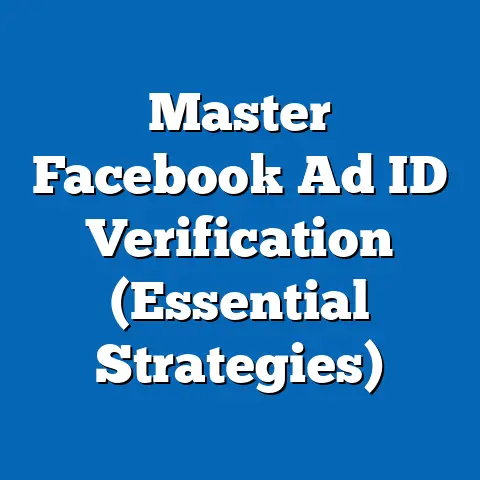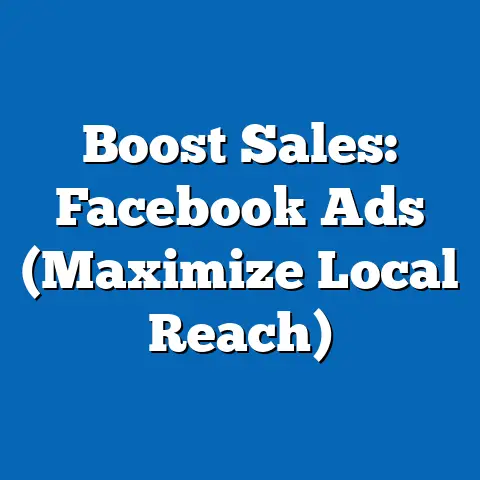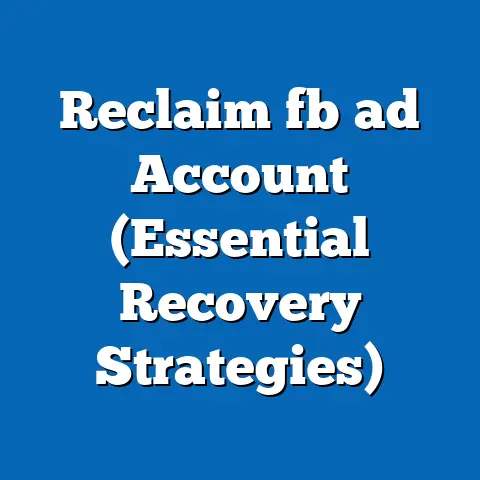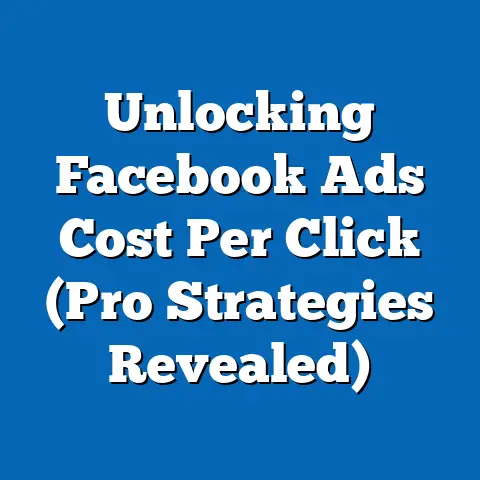Mastering Facebook Ads Disclaimers (Essential Insights)
Facebook advertising has become an indispensable tool for businesses of all sizes. The platform’s sophisticated targeting options and vast user base offer unparalleled opportunities to reach potential customers. Over the years, I’ve seen firsthand how Facebook has evolved from a simple social network to a powerful advertising platform. However, with great power comes great responsibility, and in the world of Facebook ads, that responsibility translates to understanding and implementing proper disclaimers.
Transparency and compliance aren’t just buzzwords; they’re the bedrock of successful and sustainable advertising. Neglecting these aspects can lead to serious legal repercussions and erode consumer trust. That’s why mastering Facebook ads disclaimers is not just a best practice, it’s a necessity.
Expert Tip: Always Be Transparent and Upfront with Your Audience
Before diving into the details, let me share an expert tip that I’ve found invaluable over the years: Always be transparent and upfront with your audience. This might seem obvious, but it’s often overlooked. Transparency isn’t just about ticking a box; it’s about building trust.
I recall working with a small health supplement company that initially resisted including detailed disclaimers in their ads. They feared it would make their product less appealing. However, after implementing clear and prominent disclaimers like “These statements have not been evaluated by the Food and Drug Administration. This product is not intended to diagnose, treat, cure, or prevent any disease,” their ad performance actually improved. Why? Because consumers appreciated the honesty and felt more confident in the brand. This shift led to a 20% increase in click-through rates and a boost in overall conversions. Transparency isn’t a liability; it’s an asset.
Now, let’s delve into the world of Facebook ads disclaimers and explore how you can master them for your own campaigns.
Section 1: Understanding Facebook Ads Disclaimers
Define Disclaimers in the Context of Facebook Ads
In the context of Facebook ads, disclaimers are statements that provide additional information, limitations, or warnings related to the product, service, or offer being advertised. They serve to protect both the advertiser and the consumer by clarifying potential risks, setting realistic expectations, and ensuring compliance with legal and ethical standards.
Think of disclaimers as the fine print that adds context to your ad’s claims. They’re not meant to bury important information but rather to present a complete and accurate picture. For instance, an ad promoting a weight loss program might include a disclaimer stating that “Individual results may vary” or that the program requires a specific diet and exercise regimen.
There are several types of disclaimers you might encounter, each serving a specific purpose:
- General Disclaimers: Broad statements that clarify the scope of the offer or provide basic information.
- Industry-Specific Disclaimers: Tailored to the unique requirements of particular industries, such as health, finance, or legal services.
- Geographical Disclaimers: Adjusted to comply with the regulations and laws of specific regions or countries.
Importance of Disclaimers
Disclaimers are essential for several reasons, and I can’t stress this enough.
- Legal Compliance: Disclaimers help you stay on the right side of the law. Many industries are subject to specific regulations that require certain disclosures in advertising. Failure to comply can result in hefty fines, legal action, and damage to your brand’s reputation.
- Consumer Protection: Disclaimers protect consumers by providing them with the information they need to make informed decisions. They help prevent deceptive or misleading advertising practices and ensure that consumers are aware of any potential risks or limitations associated with the product or service.
- Building Trust: As I mentioned earlier, transparency builds trust. When you’re upfront about potential limitations or risks, consumers are more likely to view your brand as honest and trustworthy. This can lead to increased customer loyalty and positive word-of-mouth.
I’ve seen numerous cases where brands have faced severe repercussions for failing to use proper disclaimers. For example, a popular fitness influencer was recently fined by the Federal Trade Commission (FTC) for promoting a weight loss supplement without disclosing that she was paid to do so and that her results were not typical. This not only damaged her credibility but also resulted in significant financial penalties.
Key Takeaway: Disclaimers are not optional; they’re a critical component of responsible and effective Facebook advertising. They protect your business, safeguard consumers, and build trust.
Section 2: Types of Disclaimers
Understanding the different types of disclaimers is crucial for ensuring that your ads are both compliant and effective. Here’s a breakdown of the most common types:
General Disclaimers
General disclaimers are broad statements that clarify the scope of your offer or provide basic information. They’re often used to address potential ambiguities or to set expectations.
Examples of general disclaimers include:
- “Offer valid while supplies last.”
- “Terms and conditions apply.”
- “See website for details.”
- “This is an advertisement.”
These disclaimers are typically placed at the bottom of the ad copy or in a small font size to avoid overshadowing the main message. While they might seem generic, they play an important role in ensuring transparency and protecting your business from potential misunderstandings.
Industry-Specific Disclaimers
Industry-specific disclaimers are tailored to the unique requirements of particular industries. These disclaimers address specific risks, regulations, or limitations that are relevant to the products or services being advertised.
Here are some examples of industry-specific disclaimers:
- Health and Wellness: “These statements have not been evaluated by the Food and Drug Administration. This product is not intended to diagnose, treat, cure, or prevent any disease.” Or, “Results may vary.” These disclaimers are essential for ads promoting health supplements, fitness programs, or medical devices.
- Financial Services: “Past performance does not guarantee future results.” Or, “Investing involves risk, including the potential loss of principal.” These disclaimers are crucial for ads promoting investment opportunities, financial advice, or lending services.
- Affiliate Marketing: “This post contains affiliate links. If you make a purchase through these links, I may earn a commission.” This disclaimer is required by the FTC for ads promoting products or services through affiliate links.
- Legal Services: “This is not legal advice. Consult with an attorney for advice specific to your situation.” This disclaimer is essential for ads offering legal information or services.
- Real Estate: “Equal Housing Opportunity.” This disclaimer is required by the Fair Housing Act for ads promoting real estate.
I remember advising a client who was launching a new skincare product line. They were tempted to make bold claims about the product’s ability to eliminate wrinkles and reverse aging. I strongly advised them to include a prominent disclaimer stating that “Individual results may vary” and that the product’s effects were not guaranteed. While they were initially hesitant, they ultimately agreed, and it turned out to be a wise decision. The disclaimer helped manage customer expectations and prevented potential legal issues down the road.
Geographical Disclaimers
Geographical disclaimers are adjusted to comply with the regulations and laws of specific regions or countries. Advertising laws can vary significantly from one jurisdiction to another, so it’s essential to tailor your disclaimers to the specific location of your target audience.
For example, ads targeting consumers in the European Union (EU) must comply with the General Data Protection Regulation (GDPR), which requires specific disclosures about data collection and usage. Similarly, ads targeting consumers in California must comply with the California Consumer Privacy Act (CCPA), which gives consumers the right to know what personal information is being collected about them and the right to opt-out of the sale of their personal information.
I once worked on a campaign that targeted both the United States and the EU. We had to create separate versions of the ads with different disclaimers to comply with the respective regulations. It was a bit more work, but it was essential for avoiding potential legal issues.
Key Takeaway: Understanding the different types of disclaimers and tailoring them to your specific industry, product, service, and target audience is crucial for ensuring compliance and building trust.
Section 3: Crafting Effective Disclaimers
Now that you understand the importance of disclaimers and the different types, let’s explore how to craft effective ones.
Best Practices for Writing Disclaimers
Crafting effective disclaimers is an art. They need to be clear, concise, and easily understood by your target audience. Here are some best practices to keep in mind:
- Use Simple Language: Avoid legal jargon or technical terms that might confuse your audience. Use plain language that everyone can understand.
- Be Specific: Don’t be vague. Clearly state the limitations, risks, or conditions that apply to your offer.
- Be Honest: Don’t try to hide or downplay important information. Be upfront about any potential drawbacks or limitations.
- Be Concise: Keep your disclaimers as short as possible while still conveying the necessary information. No one wants to read a long, convoluted disclaimer.
- Be Prominent: Make sure your disclaimers are easily visible and readable. Don’t bury them in tiny font or hide them in obscure locations.
I always advise my clients to think about their disclaimers from the perspective of their target audience. Ask yourself, “What information do my customers need to make an informed decision?” and “What potential risks or limitations should they be aware of?”
Placement of Disclaimers
The placement of your disclaimers is just as important as the content. Here are some guidelines to follow:
- Text Ads: Place your disclaimers at the bottom of the ad copy, in a font size that is easily readable but doesn’t overshadow the main message.
- Image Ads: Include your disclaimers in the image itself, in a clear and prominent location. You can also add them to the ad copy or in the ad description.
- Video Ads: Display your disclaimers on screen for a sufficient amount of time to allow viewers to read them. You can also include them in the video description.
- Landing Pages: Always include your disclaimers on your landing pages, especially if they’re related to the products or services being advertised.
I recall working on a campaign for a new online course. We created a series of video ads promoting the course’s benefits and features. To ensure transparency, we displayed a disclaimer on screen for a few seconds at the end of each video, stating that “Individual results may vary” and that “Success depends on the student’s effort and dedication.” This simple addition helped manage expectations and prevented potential misunderstandings.
Key Takeaway: Crafting effective disclaimers requires a balance of clarity, conciseness, and prominence. By following these best practices, you can ensure that your ads are both compliant and trustworthy.
Section 4: Common Mistakes to Avoid
Even with the best intentions, it’s easy to make mistakes when crafting Facebook ads disclaimers. Here are some common pitfalls to avoid:
Overshadowing the Message
One of the biggest mistakes is allowing your disclaimers to overshadow the main message of your ad. Disclaimers are important, but they shouldn’t be the first thing people notice.
Avoid using overly complicated language or long, convoluted sentences. Keep your disclaimers as short and simple as possible while still conveying the necessary information.
Ignoring Platform Guidelines
Facebook has specific advertising policies that outline what types of disclaimers are required for certain industries or products. Ignoring these guidelines can result in your ads being disapproved or your account being suspended.
Always review Facebook’s advertising policies carefully before launching a campaign and make sure that your disclaimers comply with all applicable regulations.
Neglecting Updates
Advertising laws and regulations are constantly evolving, so it’s essential to stay updated with the latest changes. Neglecting to update your disclaimers can result in your ads becoming non-compliant and potentially lead to legal issues.
Set a reminder to review your disclaimers regularly and make sure that they’re still accurate and compliant. You can also subscribe to industry newsletters or follow legal blogs to stay informed about the latest changes.
I once worked with a client who was selling CBD products on Facebook. They had created a series of ads with disclaimers that complied with the regulations at the time. However, a few months later, Facebook updated its advertising policies to prohibit the promotion of CBD products. My client was unaware of this change and continued running their ads, which resulted in their account being suspended. This highlights the importance of staying informed and adapting to changing regulations.
Key Takeaway: Avoiding common mistakes like overshadowing the message, ignoring platform guidelines, and neglecting updates is crucial for ensuring that your Facebook ads are both compliant and effective.
Section 5: Case Studies
To illustrate the importance of disclaimers in action, let’s examine a few case studies of businesses that have effectively utilized them in their Facebook ads.
Successful Campaigns
Case Study 1: Weight Loss Program
A popular weight loss program ran a Facebook ad campaign featuring testimonials from satisfied customers. To ensure transparency and manage expectations, they included a disclaimer stating that “Individual results may vary” and that “The program requires a specific diet and exercise regimen.” This disclaimer helped prevent potential misunderstandings and built trust with potential customers.
The campaign resulted in a 30% increase in sign-ups and a significant boost in brand credibility.
Case Study 2: Financial Services Company
A financial services company ran a Facebook ad campaign promoting its investment services. To comply with regulations and manage risk, they included a disclaimer stating that “Past performance does not guarantee future results” and that “Investing involves risk, including the potential loss of principal.” This disclaimer helped protect the company from potential liability and ensured that customers were aware of the risks involved.
The campaign resulted in a 20% increase in leads and a significant improvement in customer trust.
Lessons Learned
These case studies highlight several key lessons:
- Transparency is Key: Being upfront about potential limitations or risks builds trust with potential customers.
- Compliance is Essential: Adhering to advertising regulations protects your business from potential legal issues.
- Disclaimers Can Enhance Credibility: Well-crafted disclaimers can enhance your brand’s credibility and improve customer trust.
Key Takeaway: By studying successful campaigns and learning from their strategies, you can improve your own Facebook advertising efforts and achieve better results.
Section 6: Tools and Resources
To help you create effective Facebook ads disclaimers, here are some useful tools and resources:
Tools for Creating Disclaimers
- Legal Templates: Online legal template providers offer a variety of disclaimer templates that you can customize for your specific needs.
- Compliance Checkers: Online compliance checkers can help you identify potential issues with your ads and ensure that they comply with advertising regulations.
Further Reading and Resources
- Facebook Advertising Policies: Review Facebook’s advertising policies carefully to understand the specific requirements for your industry or product.
- FTC Guidelines: Consult the FTC’s guidelines on advertising and endorsements to ensure that your ads comply with federal regulations.
- Industry Newsletters: Subscribe to industry newsletters or follow legal blogs to stay informed about the latest changes in advertising laws and regulations.
Key Takeaway: Utilizing the right tools and resources can help you create effective and compliant Facebook ads disclaimers.
Conclusion
Mastering Facebook ads disclaimers is not just a matter of compliance; it’s a strategic imperative for building trust, safeguarding your business, and enhancing your advertising effectiveness. By understanding the importance of disclaimers, crafting them effectively, avoiding common mistakes, and staying updated with the latest regulations, you can ensure that your Facebook ads are both compliant and successful.
Remember the expert tip I shared at the beginning: Always be transparent and upfront with your audience. By embracing transparency and prioritizing compliance, you can build a strong and sustainable advertising strategy that benefits both your business and your customers. Go forth and create ads that are not only effective but also ethical and trustworthy.






